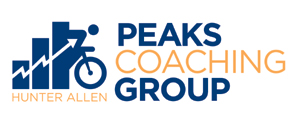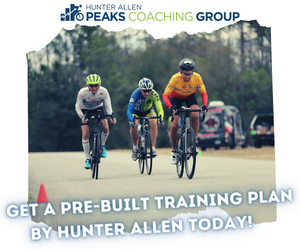

Planning for the Coming Season:
‘Classic’ or ‘Reversed Periodization’?
By PCG Elite Coach Mark Tickner
More Training and Fitness articles

James Witherell's book Bicycle History: A Chronological Cycling History of People, Races and Technology is available in prrnt or Amazon Kindle eBook versions. Just click on the Amazon link on the right.
Mark Tickner writes:
Periodization is the planning and execution of athletic training in a systematic way to train different energy systems for the demands of your racing. Periodization for endurance sports was brought to our attention by Russian physiologist Leo Matveyev and Romanian sport scientist Tudor Bompa in the 1950s through the 1960s, and into the 1970s. This article will give you 2 ways in which you might wish to try to plan your ‘off season’ training based on their theories.
‘Classic / linear / traditional’ periodization:
In this model, the thinking was that the athlete would finish their last race of the season, and then go through an approach similar to the following:
1. Last race of season (for this example I will say it is the Hawaii Ironman early - mid October).
2. Recovery period 2-3 weeks complete rest after the race to allow the body to repair itself and for the athlete to get ready for ‘base training’ (bringing us into November).
3. Base Training 12-16 weeks of ‘easy / steady’ training to build an ‘aerobic engine’ and solid foundation on which future harder / faster training would be built upon. During the base phase, the athlete would be tested every 4-6 weeks to keep training levels correct and accurate.
- Training would include long 1-1.5 hour steady swims, long 3-4 hour rides and long 1- 2 hour runs, most weeks.
- Minimal ‘threshold’ training (lactate threshold, functional threshold, anaerobic threshold… I will refer to all of these as simply ‘threshold’ to keep things easier to understand). Threshold training is at approximately your race pace over Olympic distance for each discipline (a timed 1500m swim, 40k bike time trial, or 10k run race).
- No speed-work at faster than race pace (this brings us into March).
4. Build Training Once the ‘aerobic base’ has been built, the athlete now moves into 6-8 weeks of faster threshold efforts to start to build and condition themselves to race pace.
- Faster sets in the pool such as 20 x 100fc off :20 at or slightly faster than race pace.
- Bike rides in TT position at goal race pace such as 6 x 10:00, 4 x 20:00, 3 x 1hr (built progressively longer through the weeks) at race pace.
- Running 10-20 x 400m at race pace off :45 on the track. Between these harder sessions the athlete would be completing recovery or endurance training.
- Athlete can race in 1-2 ‘B’ Olympic and middle distance races at key points (week 3 and 8 of this phase, as an example) in this phase to ‘test fitness’ and try ‘race day strategies’.
- All through the build phase, the athlete is still swimming, biking and running longer sessions (1.5hr swim, 5hr+ bikes, 2hr+ runs). (We are now into May approx.).
5. Taper / Peaking for Race 3 weeks before the Ironman distance. Volume now decreases in week 1 by approximately 25%. Again decreasing a further 25% (50% from normal volume) in week 2, and finally a further 25% (75% from normal volume) in week 3 / race week.
- Race day intensity is maintained with perhaps a little extra speed to ‘blow out the cobwebs’ from all the aerobic training and to ‘spark the anaerobic system’ a little so the athlete does not feel too lethargic and ‘flat’ on race day.
- Recovery is paramount now and the athlete is encouraged to get quality sleep whenever possible.
- Nutrition and hydration is focused on throughout the weeks to keep muscles full of energy and the athlete hydrated.
- Sessions tend to get shorter as the race gets closer during the last week.
- Athlete then races their first key race of season! (We are now at the end of May).
For many athletes, the classic periodization model works very well, especially if they live in the warmer southern hemisphere during October – May (Australia, Asia, India, South Africa etc.). Athletes using this model have seen tremendous success over many years. However, here are some things to consider if you live in the northern hemisphere and wish to try to follow the classic periodization plan.
- Cold, rain, snow, and other difficult weather conditions make training consistently outside from October – May in northern hemisphere countries (North America, UK, Northern France, Germany, Switzerland etc.) very difficult and sometimes dangerous.
- Athletes could build race endurance, as they get closer to their race in the warmer months instead, when training will be more enjoyable.
- As each phase is introduced with more speed, the endurance training is reduced…triathlon is an endurance sport even for a 1 hour sprint event!
- Athletes who have trained exclusively ‘base’ and with minimal or no speed-work can get injured when introducing speed work into their training off slow / steady training.
- Daylight hours for training become harder to come by if working 40 hours a week, and training in the dark is obviously more dangerous.
Reverse Periodization:
More recently over the last 1-2 decades, many athletes and coaches have favored the reverse periodization method of starting with speed work, and then building the endurance work in systematically as the weather gets warmer. This method has been exclusively used by world renowned coach to World and Olympic champions, Brett Sutton, for over 20 years. The reasoning is that you start with speed, as you have finished the season at your best ‘peak’ shape, so chances of injury will be lower, and training more tolerable at the higher intensities. It also gives you a mental and physical break from going back to longer training that you have been working on the past few months in preparation for your races! Shorter sessions are easily completed time wise, make you feel fresher as volume of training will be lower, and technique can be further improved by completing shorter sets better.Here is how we could break training down:
1. Last race of season (for this example I will say it is the Hawaii Ironman again in early - mid October).
2. Recovery period 2 weeks complete rest (or one easy session a day) after the race to allow the body to repair and for the athlete to get ready for the next phase of training (bringing us into November). Regardless of which periodization method you use, all athletes need rest after a long hard race season!
3. Athlete Limiter Focus 4 weeks of focused training on the athlete’s weakest discipline whilst maintaining fitness in the other 2 disciplines (bringing the program into December by the end of the 4 weeks…but for Christmas and New Year’s, family time is most important so no ‘must do’ sessions during this time…allow the athlete to enjoy themselves!). The athlete would also build back up to 2 sessions a day if the athlete was used to this amount of training in their normal training week. Intensity is increased mainly in limiter discipline.
4. Speed Training (Sprint / Olympic distance focus). 6 weeks of focused short course training (mainly completed inside) at close to the athlete’s threshold, maybe slightly above, but with plenty of recovery between efforts / intervals (the athlete would now be in mid-end of February approx.). The sessions are short and focused and the volume will be lower than normal. This will increase the athlete’s motivation and keep them mentally eager for the longer training that will follow this phase. Testing in this phase is important in the limiter discipline 2-3 times and the athlete could finish this period with an Olympic distance race or 10km-half marathon if available (followed by 5 days easy training of 1 session a day).
5. Strength Training (half ironman distance focus). 8 weeks of middle distance training where strength work in all 3 disciplines is focused upon (the program would now be approx. mid-end of April). Sessions start to increase in volume now with the athlete almost training up to their normal hours. Speed may be included from previous phase but in a systematic way to push fitness further. A middle distance race would be ideal at the end of this phase but will be after a 1-2 week ‘taper’ (5-10 days easy training after race).
6. Endurance Training (ironman distance focus). 10 weeks of focused longer training to which many athletes are used to doing (now the program in this phase finishes in June / July approx.). The volume is at the highest, and long swims, bikes, and runs are now implemented most weeks. Fitness is still increased by shorter faster training close to threshold (Olympic distance pace) with an increased focus on recovery, hydration, and nutrition. As this phase is most draining physically and mentally for many athletes, it is important to keep sessions fresh, motivating, fun, and challenging so the athlete completes this important phase to prepare their body physically and mentally for their key ‘A’ race.
It is important for you as an athlete or coach to decide which periodization model might fit best with each athlete, depending on many factors such as: location of athlete around the world, weather in athlete’s location, time available to train, physical and mental state of athlete, when the races for next season will be etc. Once you have all the information established, you must then break down your annual training plan around the periodization model of your choosing. Then when everything is in place, you add the specific training sessions to each phase…and that is another topic for another article!
.









